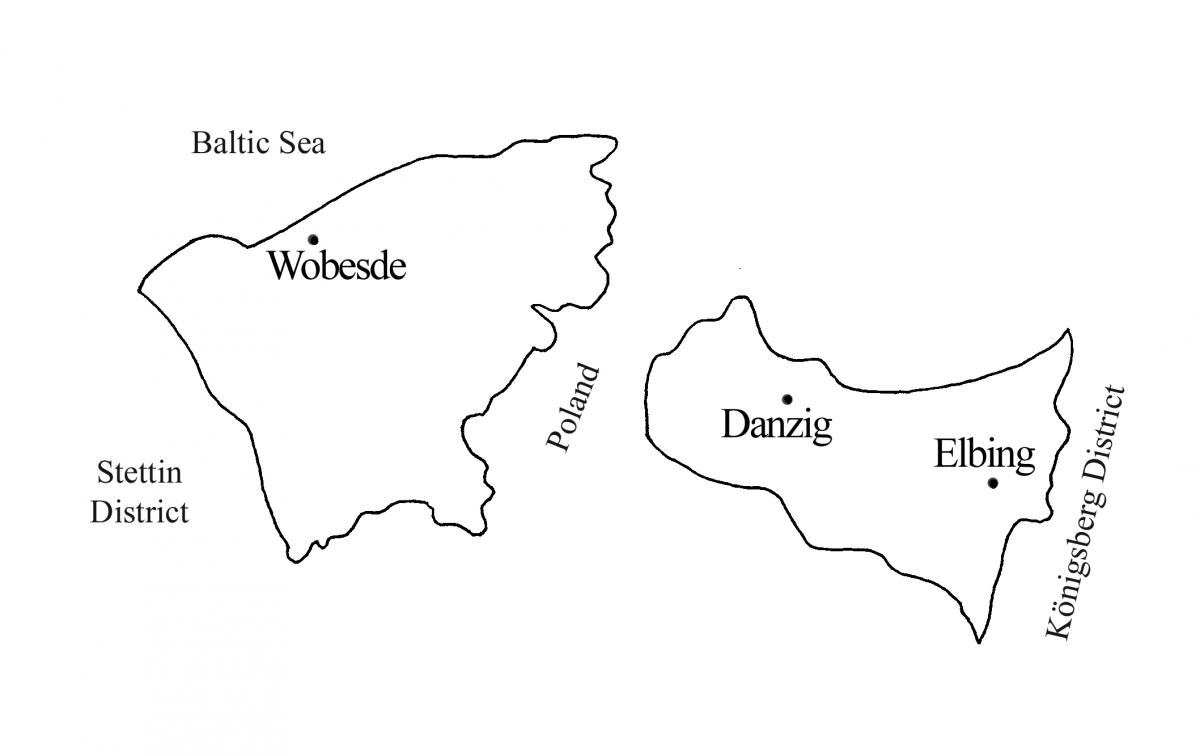Danzing District
Roger P. Minert, In Harm’s Way: East German Latter-day Saints in World War II (Provo, UT: Religious Studies Center, Brigham Young University, 2009), 203-5.
The Danzig District of the East German Mission was in a unique situation. Following World War I, Danzig was declared a Free City and thus was independent from Germany. Therefore, the city was the only part of the mission that was not in Germany. Danzig (now Gdansk, Poland) is a port on the Baltic Sea. As a Free City with German-speaking inhabitants, it was positioned to serve both Germany and Poland commercially. South and west of Danzig was the so-called Polish Corridor, transferred from Germany to Poland in the Treaty of Versailles (1919) as an access to the sea, an arrangement that angered millions of Germans who lived in that region. Returning the Polish Corridor to Germany was a prime incentive for Hitler to conquer Poland in 1939.
| Danzig District[1] | 1939 | 1940 | 1941 | 1942 |
| Elders | 13 | 14 | ||
| Priests | 6 | 7 | ||
| Teachers | 5 | 6 | ||
| Deacons | 15 | 12 | ||
| Other Adult Males | 53 | 30 | ||
| Adult Females | 102 | 101 | ||
| Male Children | 8 | 10 | ||
| Female Children | 16 | 14 | ||
| Total | 218 | 194 | 201 | 212 |
The Danzig District consisted of only three branches: Danzig, Elbing, and Wobesde. As a result of the confusing political boundaries, Wobesde (fifty-five miles to the west) was in the province of Pomerania in Germany, whereas Elbing (forty miles to the east) was in East Prussia, another German province. The disadvantages of the political situation of the Latter-day Saint branches in the district were evident in such incidents as the one recorded in the East German Mission History for Sunday, November 13, 1938:
The fall conference of the Stolp [later Danzig] District was held in Danzig. Members of the Elbing and Wobesde branches could not attend, due to the fact that the “group” passport which they had did not fulfill the requirements to enter the Free city of Danzig, even though they had previously been told that such a passport would be sufficient. In spite of this, an inspirational conference was held, at which Pres. Rees took active part.[2]
Emil Voge (born 1895) was called to serve as the president of the Danzig District in February 1938. He lived in Lauenburg, Germany—about forty miles west of Danzig. Each time he wanted to visit the branches in Danzig and Elbing, he was required to cross two or even three international boundaries (from Germany into Poland, then into the Free City of Danzig, then east into Germany [East Prussia]).
 The Free City of Danzig was independent before World War II. German-speaking members of the Church in the Polish Corridor attended the closest branch in Danzig or in Germany.
The Free City of Danzig was independent before World War II. German-speaking members of the Church in the Polish Corridor attended the closest branch in Danzig or in Germany.
The last entry in the East German Mission History regarding the Danzig District is dated February 1, 1939. A meeting for district missionaries was held in the rooms of the Elbing Branch. Mission president Alfred C. Rees came from Berlin, and other attendees came from branches in the Danzig and Königsberg districts. The record indicates that forty-five members and forty-nine friends attended the meeting.[3]
The tension along the German-Polish border had been emphasized and bemoaned by Nazi propaganda ever since Hitler came to power in 1933. The German dictator constantly demanded from the international community that the Polish Corridor be returned to Germany so that ethnic Germans living there would not be subjected to harassment by the Polish inhabitants of the region. The persecution was very likely not as intense as the German media represented it, but it was at least in some cases genuine. Rudi Seehagen (born 1925) of the Berlin Spandau Branch was in the region in 1938 and recalled the following incident involving Germans in Germany and in Poland:
Attendees at the district conference in Danzig on April 12, 1941, in front of the Danzig meetinghouse (I. Reimer Ebert)
In 1938, I was with the Hitler Youth for a week along the Polish border. The border was just a creek there. There was a former German village there. The Germans came from their village [in Poland] over to the creek across from us and sang German songs with us. The Polish police followed them and beat the people to get them away from us (and they beat women and children), and I saw that with my own eyes.[4]
The German army invaded Poland on Friday, September 1, 1939, but the armed conflict lasted only twenty-one days. For more than five years, Poland was under German military occupation. Danzig was again a German city, and Latter-day Saints traveling in and through the area no longer had any difficulties at border crossings.
In the fall of 1944, Soviet troops invaded East Prussia (the Königsberg District). A few months later, they approached Danzig. The members of the Danzig, Elbing, and Wobesde Branches who had not already fled to the west did their best to escape the enemy. By the summer of 1946, all members of the three branches of the Danzig District had left the area, and the Church no longer had any presence there.
Notes
[1] Presiding Bishopric, “Financial, Statistical, and Historical Reports of Wards, Stakes, and Missions, 1884–1955,” CR 4 12, 257.
[2] East German Mission Quarterly Reports, 1938, no. 46, East German Mission History.
[3] Ibid., 1939, no. 55.
[4] Rudi Seehagen, interview by the author in German, Sandy, Utah, March 9, 2006; summarized in English by Judith Sartowski.
